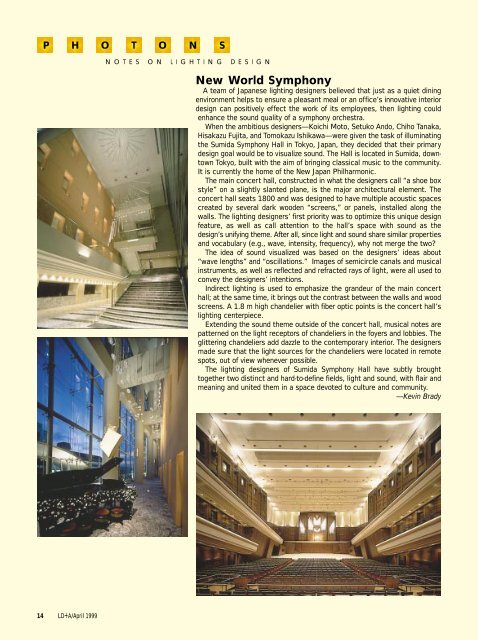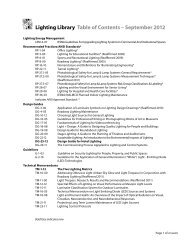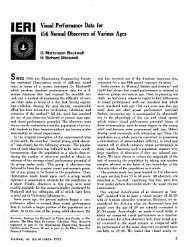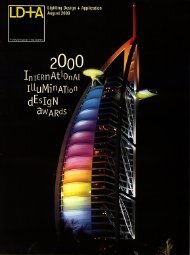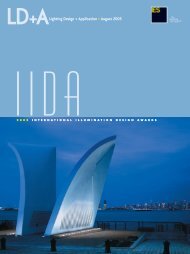lightfair international - Illuminating Engineering Society
lightfair international - Illuminating Engineering Society
lightfair international - Illuminating Engineering Society
Create successful ePaper yourself
Turn your PDF publications into a flip-book with our unique Google optimized e-Paper software.
P H O T O N S<br />
NOTES ON LIGHTING DESIGN<br />
New World Symphony<br />
A team of Japanese lighting designers believed that just as a quiet dining<br />
environment helps to ensure a pleasant meal or an office’s innovative interior<br />
design can positively effect the work of its employees, then lighting could<br />
enhance the sound quality of a symphony orchestra.<br />
When the ambitious designers—Koichi Moto, Setuko Ando, Chiho Tanaka,<br />
Hisakazu Fujita, and Tomokazu Ishikawa—were given the task of illuminating<br />
the Sumida Symphony Hall in Tokyo, Japan, they decided that their primary<br />
design goal would be to visualize sound. The Hall is located in Sumida, downtown<br />
Tokyo, built with the aim of bringing classical music to the community.<br />
It is currently the home of the New Japan Philharmonic.<br />
The main concert hall, constructed in what the designers call “a shoe box<br />
style” on a slightly slanted plane, is the major architectural element. The<br />
concert hall seats 1800 and was designed to have multiple acoustic spaces<br />
created by several dark wooden “screens,” or panels, installed along the<br />
walls. The lighting designers’ first priority was to optimize this unique design<br />
feature, as well as call attention to the hall’s space with sound as the<br />
design’s unifying theme. After all, since light and sound share similar properties<br />
and vocabulary (e.g., wave, intensity, frequency), why not merge the two<br />
The idea of sound visualized was based on the designers’ ideas about<br />
“wave lengths” and “oscillations.” Images of semicircle canals and musical<br />
instruments, as well as reflected and refracted rays of light, were all used to<br />
convey the designers’ intentions.<br />
Indirect lighting is used to emphasize the grandeur of the main concert<br />
hall; at the same time, it brings out the contrast between the walls and wood<br />
screens. A 1.8 m high chandelier with fiber optic points is the concert hall’s<br />
lighting centerpiece.<br />
Extending the sound theme outside of the concert hall, musical notes are<br />
patterned on the light receptors of chandeliers in the foyers and lobbies. The<br />
glittering chandeliers add dazzle to the contemporary interior. The designers<br />
made sure that the light sources for the chandeliers were located in remote<br />
spots, out of view whenever possible.<br />
The lighting designers of Sumida Symphony Hall have subtly brought<br />
together two distinct and hard-to-define fields, light and sound, with flair and<br />
meaning and united them in a space devoted to culture and community.<br />
—Kevin Brady<br />
14 LD+A/April 1999


